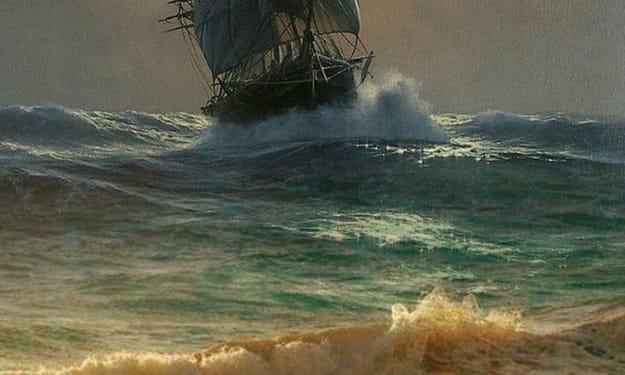Content warning
This story may contain sensitive material or discuss topics that some readers may find distressing. Reader discretion is advised. The views and opinions expressed in this story are those of the author and do not necessarily reflect the official policy or position of Vocal.
When to Leave: Warning Signs and Unexpected Dangers Around the World!
Hidden Dangers: Nature's Warnings and Perils Across the Globe!

The Blazing Darvaza Crater
Deep in the deserts of Turkmenistan lies the Darvaza Crater, also known as the "Door to Hell." This massive, burning pit illuminates the dark desert with a bright orange glow. It was created decades ago when geologists were mining for gas and an underground void collapsed, forming a crater as wide as half a soccer field and as deep as a five-story building. To prevent harm from the escaping gases, scientists set the gas alight, expecting the fire to last a few days. Nearly fifty years later, the crater is still burning. In 2013, an explorer descended into the crater for the first time, discovering unique bacteria that thrive in this fiery environment, revealing the extraordinary adaptability of life.
Earthquake Lights: A Mysterious Phenomenon
In 2009, a man in L'Aquila, Italy, witnessed flickering lights above the stone streets. Recognizing the danger, he moved his family to safety just before a massive 8.3 magnitude earthquake struck. These lights, once dismissed by scientists, are now recognized as precursors to seismic activity. Surveillance technology has captured various forms of these lights, including bright flashes, light columns, and slow-moving balls of light. Although their exact cause remains unknown, theories suggest they might be related to gases like radon released during seismic activity. This phenomenon underscores the importance of understanding natural warning signs that can potentially save lives.
Hidden Dangers in Nature: The Fox's Den
Foxes, known for their cunning nature, dig elaborate burrows called fox earths. These dens provide shelter during bad weather and serve as nurseries for their young. Found in lush forests, grasslands, and even tundra, fox dens typically feature multiple sections, including a main den, food storage areas, and additional tunnels. Despite their adaptability, foxes usually avoid humans, but it's important to maintain a safe distance if you encounter one. Their dens are not only architectural marvels but also essential for their survival, reflecting the intricate balance of nature.
Unseen Hazards of Unique Lakes
Around the world, lakes hold hidden dangers beneath their serene surfaces, each with its own unique set of risks that make them fascinating yet potentially perilous.
- Lake Kaindy, Kazakhstan: Formed by an earthquake in 1911, this lake is known for its submerged forest. While the clear waters offer a fascinating view, they also pose risks due to the cold temperatures and underwater obstacles. Divers and swimmers must navigate carefully to avoid entanglements.
- Boiling Lake, Dominica: With temperatures reaching nearly 200°F around the edges, this lake releases dangerous gases like carbon dioxide and sulfur, making it hazardous. The fluctuating temperatures add to its unpredictability.
- Lake Nyos, Cameroon: One of the few erupting lakes, Lake Nyos can release lethal gas eruptions, similar to a shaken soda can. This phenomenon can occur without warning, posing a significant threat to nearby communities.
- Lake Natron, Tanzania: Known for its high salinity and corrosive waters, this lake is inhospitable to most life forms but is a sanctuary for flamingos. The extreme conditions here highlight the resilience and adaptability of certain species.
- Lake Nicaragua: Home to bull sharks that can survive in freshwater, making swimming here dangerous. The sharks' adaptability and presence in freshwater environments are remarkable yet cautionary.
- Great Blue Hole, Belize: A popular diving spot, its depths are filled with tunnels and a layer of hydrogen sulfide, making deep dives perilous. The beauty of this natural wonder is matched by the risks it presents to divers.
- Lake Lanier, Georgia, USA: Despite being a popular recreation spot, hidden debris and low visibility make it hazardous for swimmers and boaters. The lake's popularity contrasts sharply with the dangers lurking beneath its surface.
- Grand Prismatic Spring, Yellowstone: Known for its vivid colors, this hot spring's center reaches near-boiling temperatures, prohibiting any swimming. The stunning visual display is a reminder of the powerful geothermal activity beneath the park.
Conclusion
From the fiery depths of the Darvaza Crater to the eerie lights that precede earthquakes, and the hidden perils in serene lakes, our planet is full of surprising and sometimes dangerous phenomena. Awareness and caution are key when exploring these fascinating yet hazardous locations. Whether you're venturing into remote deserts, hiking through dense forests, or diving into crystal-clear waters, understanding the risks and respecting nature's warnings can make the difference between an unforgettable adventure and a dangerous encounter. The beauty and mystery of our world come with inherent risks that highlight the need for vigilance and respect for the environment.
About the Creator
Enjoyed the story? Support the Creator.
Subscribe for free to receive all their stories in your feed. You could also pledge your support or give them a one-off tip, letting them know you appreciate their work.





Comments
There are no comments for this story
Be the first to respond and start the conversation.